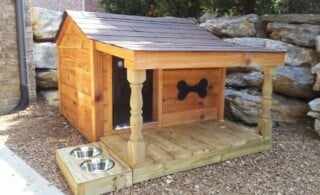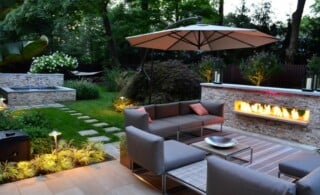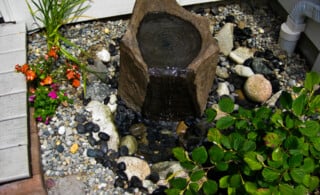
No matter how much you love your neighborhood, everyone needs their privacy. While fences work, they may not provide the level of privacy and style you want. Plants, however, not only provide an extra level of privacy, but can also add beauty to your yard by creating a more natural-looking barrier.
If you want to install a living fence or living wall, consider this list of the 15 best privacy plants, and see if these can give your yard the look you want and the privacy you need. If you’re not sure what will work best in your yard, it’s best to consult a local landscaping company.
Table of Contents
- USDA Plant Hardiness Zones
- Best Trees for Privacy
- Best Shrubs for Privacy
- Where to Plant Privacy Plants
- Tips for Spacing Your Shrubs
- How to Trim Your Hedges
- Check for Plant Regulations
USDA Plant Hardiness Zones
The USDA has established plant hardiness zones by dividing geographical areas by climate temperature. Using these zones, you can see whether a plant can grow and survive the temperature changes in your area.

Best Trees for Privacy
1. Emerald Arborvitae

Sometimes called a “green giant arborvitae” or an emerald green arborvitae, this pyramidally shaped evergreen tree grows in USDA hardiness zones 3 to 7 and doesn’t become discolored in winter like other arborvitae.
They provide excellent privacy if planted 2 to 3 feet apart, growing at the rate of less than a foot a year to a height of 10 to 15 feet. These low-maintenance plants thrive with at least four hours of full sun each day. As a bonus, they provide good nesting sites for birds and a year-round food source for wildlife.
2. European Hornbeam

The European hornbeam’s oval or column shape makes it a great choice for a privacy screen or windbreak, growing as high as 40 feet tall and as wide as 30 feet. It grows best in full sun or partial shade, and you can find it in hardiness zones 5 to 8.
Its dark green summer leaves turn yellow in autumn, and, like a deciduous tree, it drops its leaves in winter. In addition to being used in hedges, you can find these along residential streets, in median strips, and parking lots.
3. Leyland Cypress

With its bluish-green needles, the Leyland cypress offers a beautiful, slender oval shape to your landscape. Its immense height—anywhere from 40 to 60 feet—makes it an excellent choice for a living wall when planted in a mass.
Able to grow in hardiness zones 6 to 10, this evergreen gives year-round color and privacy protection, growing about 2 feet each year. Just keep in mind that the Leyland cypress is toxic to pets.
4. Skip Laurel

These glossy, broadleaf evergreens make a great privacy hedge or screen, growing twice as tall as they are wide. Deer-proof with year-round color, you can enjoy the laurel’s privacy as well as its fragrant white blossoms that bloom in the spring.
Skip laurels grow best in full sun or partial shade and can be grown in hardiness zones 5b to 9b. They grow up to 2 feet a year and can reach 10 to 15 feet.
5. Norway Spruce

This pyramidal evergreen grows best in cool, northern climates and can be found in hardiness zones 3a to 7a. It prefers moist soils and does not thrive in the heat. The Norway Spruce can grow up to 75 feet, but you can also find dwarf versions. Be on the lookout for pests such as aphids, red spiders, borers, and budworms.
6. Southern Magnolia

One of the world’s oldest known tree specimens, the Southern magnolia is a broadleaf evergreen that can grow as high as 80 feet and as wide as 40 feet. As its name suggests, it grows best in the South, and it’s native to coastal plains in the southeast from Texas over to Florida and up through North Carolina.
Although you need to provide mulch at its base to prevent erosion problems, the Southern magnolia doesn’t attract pests and isn’t prone to diseases. It sheds its leathery leaves frequently, both in spring and autumn, but it boasts large, fragrant flowers during the spring and summer.
7. Concolor Fir

This long-lived tree can provide you with shade for a lifetime and beyond. The concolor fir can live up to 350 years and grow as tall as 150 feet (at a rate of a foot or two a year). But you can expect this cone-shaped tree to reach heights of 30 to 50 feet and widths of 15 to 25 feet at maturity in a landscape setting.
Found in hardiness zones 3 to 7, it can grow at higher elevations, including 6,000 to 11,000 feet in the Colorado and New Mexico Rockies. Near the West Coast in California and Oregon, it can be found as low as 2,300 feet. It grows best in full sun and can be a great privacy option for large yards.
8. Eastern White Pine

A widely used tree for lumber in the 1700s and 1800s, the Eastern White Pine has become an attractive choice as a privacy screen.
The Eastern White Pine grows best in full sun and humid, cool climates. It grows 2 feet a year, reaching 50 to 80 feet at maturity. The bigger it gets, the less dense the needles look in terms of privacy. Because it’s also highly flammable, you should avoid planting it in the defensible space around your home.
Best Shrubs for Privacy
9. Hicks Yew

Their evergreen nature and potential to grow 10 to 12 feet high make yews a great option for privacy hedges and screens. Not only do you get year-round color, but also, with red berries set against dark-green needles, this colorful bonus provides a necessary and attractive food source for birds.
This yew has an upright, columnar growth habit, similar to the arborvitae. Hicks yew can thrive in full sun or partial shade and grow in hardiness zones 4 to 7 at a rate of about a foot per year.
10. Green Velvet Boxwood

Although green velvet boxwoods grow slowly, gaining just 6 to 12 inches a year, these evergreen shrubs can reach a height and width of 3 to 4 feet at maturity. Easy to prune to whatever shape you would like, these hardy shrubs can also be left alone to grow naturally.
If you want an evergreen with no needles, the boxwood’s glossy, small, smooth leaves make an attractive option. Grown in zones 5 to 8, boxwoods enjoy full sun but appreciate some dappled shade, especially in hotter climates. Full shade affects the fullness of the shrub.
11. Golden Euonymus

An evergreen shrub, golden euonymus grows in zones 6 to 9 with interesting variegated leaves. Although it can reach 5 to 10 feet tall, this shrub grows at a moderate pace, gaining 1 to 2 feet a year. If you get high deer traffic, they may damage the shrub.
It grows well in average moisture and well-drained soil but does not do well in wet soil. While golden euonymus grows best in full sun, it does appreciate some dappled shade in the afternoon, especially in hotter climates.
12. Holly

Although typically associated with winter holidays, holly thrives year-round in full sun and can also grow in partial shade. Holly grows in a wide, pyramidal shape at a rate of about 1 to 2 feet a year, reaching a mature height of 15 to 25 feet. It grows best in well-drained soil in zones 5b to 9b.
If you want the colorful berries that attract birds, be sure to plant both male and female plants. Just keep in mind those berries are mildly toxic to humans and pets.
13. Juniper

Another evergreen, junipers have spindly, needle-like leaves and can grow from 5 to 10 feet. Because junipers have a low, spreading growth habit, you will have privacy from the ground up.
They grow well in full sun or partial shade in a wide range of hardiness zones, from 2a to 8a. These deer-resistant, drought-tolerant and low-maintenance shrubs should be planted in well-drained soil.
14. Lilac

This low-maintenance deciduous shrub grows in full sun and, once established, only needs watering during prolonged periods of drought. It does require yearly pruning to promote flowering, ensure air circulation and prevent powdery mildew.
Lilacs have dark green foliage with fragrant purple or lavender flowers that bloom in early spring. When used as a hedge plant, they should be planted 3 to 4 feet apart. Commonly found in hardiness zones 3 to 7, they grow at a rate of 1 to 2 feet a year and reach a height of 12 to 16 feet.
15. Redosier Dogwood

Like the lilac, the deciduous dogwood drops its leaves, but after, its branches turn red for the winter months. Planted in mass, especially against evergreen plants, its red twigs offer stunning winter interest. The dogwood grows about up to 2 feet a year and reaches a mature height of 7 to 9 feet, making it a good choice for privacy fences. Dogwoods grow in hardiness zones 2 to 7 and thrive with four hours of direct sunlight a day.
Where to Plant Privacy Plants

You can naturally incorporate privacy plants into your landscape using a variety of methods:
- Fencing: You can plant them behind or in front of a fence.
- Pots: If you plant them into pots, you can move them around and situate them as you please.
- Screening: You can build a plant wall for full privacy.
Tips for Spacing Your Shrubs

When creating a privacy hedge, you have a lot to consider. You must think about space requirements and limitations as well as pruning needs. You should anticipate what you want your living wall to look like at full growth before you can begin planting.
The following sections offer specific tips to get you started off right.
Create Space and Rows
If you plant shrubs and trees too close together, you cause overcrowding, leading to plant disease and distress. Giving your plants enough space allows them to grow to their full potential, which is your goal if you’re creating a privacy hedge.
The amount of space you leave between plants depends on what kind of plants you choose. Your plant tag always lists how wide the plant should be at maturity. Plant at that width if you want your trees and shrubs to reach their full growth potential.
If you want a thicker hedge, you can plant closer, but just know that your trees and shrubs may not get as big as you like. You can also use the option of planting two staggered rows. Doing so results in having the space between plants in one row hidden by a plant in the next row.
Consider the Height of Your Hedge
In addition to thinking about the width between your plants, you need to consider how high you want your hedge to be before selecting a tree or shrub. Taller hedges can be handled by something like arborvitae, while a shorter hedge might work best with boxwoods.
Remember that while a hedge gives you privacy by blocking the view of others, that hedge also blocks your view. So if you like the scenery around your home, select a plant that won’t take away your view while also offering a sense of privacy.
When you think about height, also check to see whether the plant you want to use needs pruning. Consider whether you want to possibly scale a ladder to prune a tree or shrub once it reaches its mature height or hire a local gardener.
How to Trim Your Hedges

To keep your hedges looking good and functioning well—and in some cases, to keep them from growing onto a neighbor’s property—consider a hedge trimming service near you. You may also need to trim trees to keep them looking nice if you decide to plant those instead of shrubs.
We’ll explain the basics of pruning your hedges into healthy, prolific plants.
When to Trim Shrubs
Pruning time is determined by whether your plant is flowering or evergreen. Evergreen hedges should be trimmed or pruned in very early spring, such as March and April before their dormancy period ends.
For flowering hedges, check your plant information to see whether yours blooms on old or new growth. Trim plants that flower on new wood in early spring so they’ll bloom on schedule, but trim old-wood bloomers right after they’re done flowering so they can set buds for the following year.
Narrow Top, Wide Bottom
Avoid pruning hedges at the bottom. Doing so creates shade for lower branches and keeps them from receiving the sunlight they need to flourish. You also end up with a top-heavy shrub that looks unsightly near ground level. So think about the shape of a traditional Christmas tree while pruning to trim your way to a healthy plant.
Formal vs. Informal Hedges
Determine whether you want a natural-looking hedge or a more sculpted, formal look before you select the type of shrub you want to use. You’ll certainly want to do so before pruning, as some cannot tolerate it. Consider the differences:
- Formal hedges have more straight edges or curves and uniform shapes like the kind you see in large English gardens. You must clip formal hedges tightly to keep them neat, which means you have to prune them more often to keep their sharp, clean shape.
- Informal hedges can be created by lines of shrubs that are kept in a more natural shape. You don’t have to tend to them as often, if at all. You only trim informal hedges based on specific plant needs, such as encouraging flowering. Such pruning is required just once a year.
Check for Plant Regulations
Before you choose your privacy plants, check these places first to be sure your choices conform to the needs of your community:
- Your homeowners’ association or city’s zoning rules: You need to be sure that what you’re planting complies with any rules that govern your location.
- Local university extension or master gardener group: These places can tell you whether the plant you want to use is an invasive species that shouldn’t be grown in your area. If you live in a community with strict watering rules, they can also tell you whether water restrictions will make it difficult to establish the plants you want to use.
Although you have a lot to consider when choosing, planting, and maintaining natural privacy screens, you can use these tips and ideas to get started. Before you know it, you’ll enjoy your own natural privacy around your home.
 Dog Houses
Dog Houses  Outdoor Rooms: Enhance Your Outdoor Living
Outdoor Rooms: Enhance Your Outdoor Living  Garden Fountains: Making Mother Nature Come Home
Garden Fountains: Making Mother Nature Come Home  Improve Your Fishing Technique at Home: The Complete Guide to a Backyard Fishing Pond
Improve Your Fishing Technique at Home: The Complete Guide to a Backyard Fishing Pond  Crafts to Spruce Up Your Garden
Crafts to Spruce Up Your Garden 

Are You Familiar With This Topic? Share Your Experience.